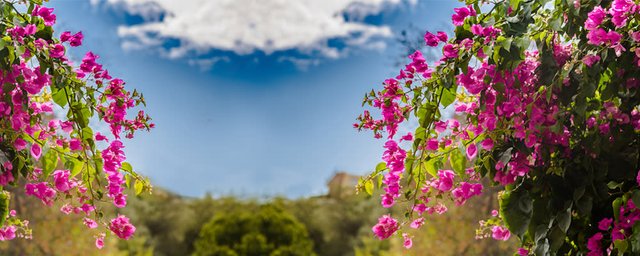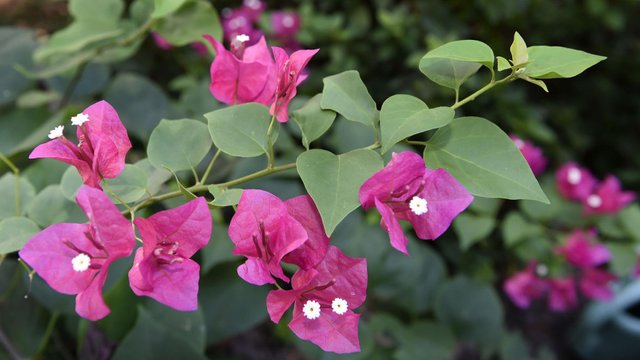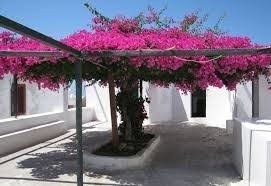
Commonly found surrounding the front doors; these flowers are known as the paper-flowers in Bengali as the texture of these flowers is similar to paper. They grow all the year around and appear to be similar to bushes.

The species grow 1 to 12 metres (3 to 39 ft) tall, scrambling over other plants with their spiky thorns. They are evergreen where rainfall occurs all year, or deciduous if there is a dry season. The leaves are alternate, simple ovate-acuminate, 4–13 cm long and 2–6 cm broad. The actual flower of the plant is small and generally white, but each cluster of three flowers is surrounded by three or six bracts with the bright colours associated with the plant, including pink, magenta, purple, red, orange, white, or yellow. Bougainvillea glabra is sometimes called "paper flower" because its bracts are thin and papery. The fruit is a narrow five-lobed achene.
The first European to describe these plants was Philibert Commerçon, a botanist accompanying French Navy admiral Louis Antoine de Bougainville during his voyage of circumnavigation of the Earth, and first published by Antoine Laurent de Jussieu in 1789.[2] It is possible that the first European to observe these plants was Jeanne Baret, Commerçon's lover and assistant, who was an expert in botany. Because she was not allowed on ship as a woman, she disguised herself as a man in order to make the journey (and thus became the first woman to circumnavigate the globe).[3]
Bougainvillea glabra in Kerala
Twenty years after Commerçon's description, it was first published as 'Buginvillæa' in Genera Plantarum by A. L. de Jussieu in 1789. The genus was subsequently spelled in several ways until it was finally established as "Bougainvillea" in the Index Kewensis in the 1930s. Originally, B. spectabilis and B. glabra were undifferentiated until the mid-1980s when botanists classified them as distinct species. In the early 19th century, these two species were the first to be introduced into Europe, and soon, nurseries in France and Britain sold these varieties in Australia and throughout their former colonies. Meanwhile, Kew Gardens distributed plants it had propagated to British colonies throughout the world. Soon thereafter, a crimson specimen in Cartagena, Colombia was added to the genus descriptions. Originally thought to be a distinct species, it was named B. buttiana in honour of the European who first encountered it. However, later studies classified it as a natural hybrid of a variety of B. glabra and possibly B. peruviana - a "local pink bougainvillea" from Peru. Natural hybrids were soon found to be common occurrences all over the world. For instance, around the 1930s, when the three species were grown together, many hybrid crosses were produced almost spontaneously in East Africa, India, the Canary Islands, Australia, North America, and the Philippines.

Beautiful . I like boogainvillea lot. 🌸
Downvoting a post can decrease pending rewards and make it less visible. Common reasons:
Submit
i also love Bougainvillea
Downvoting a post can decrease pending rewards and make it less visible. Common reasons:
Submit
Colorful and sweet photography 😍
Downvoting a post can decrease pending rewards and make it less visible. Common reasons:
Submit